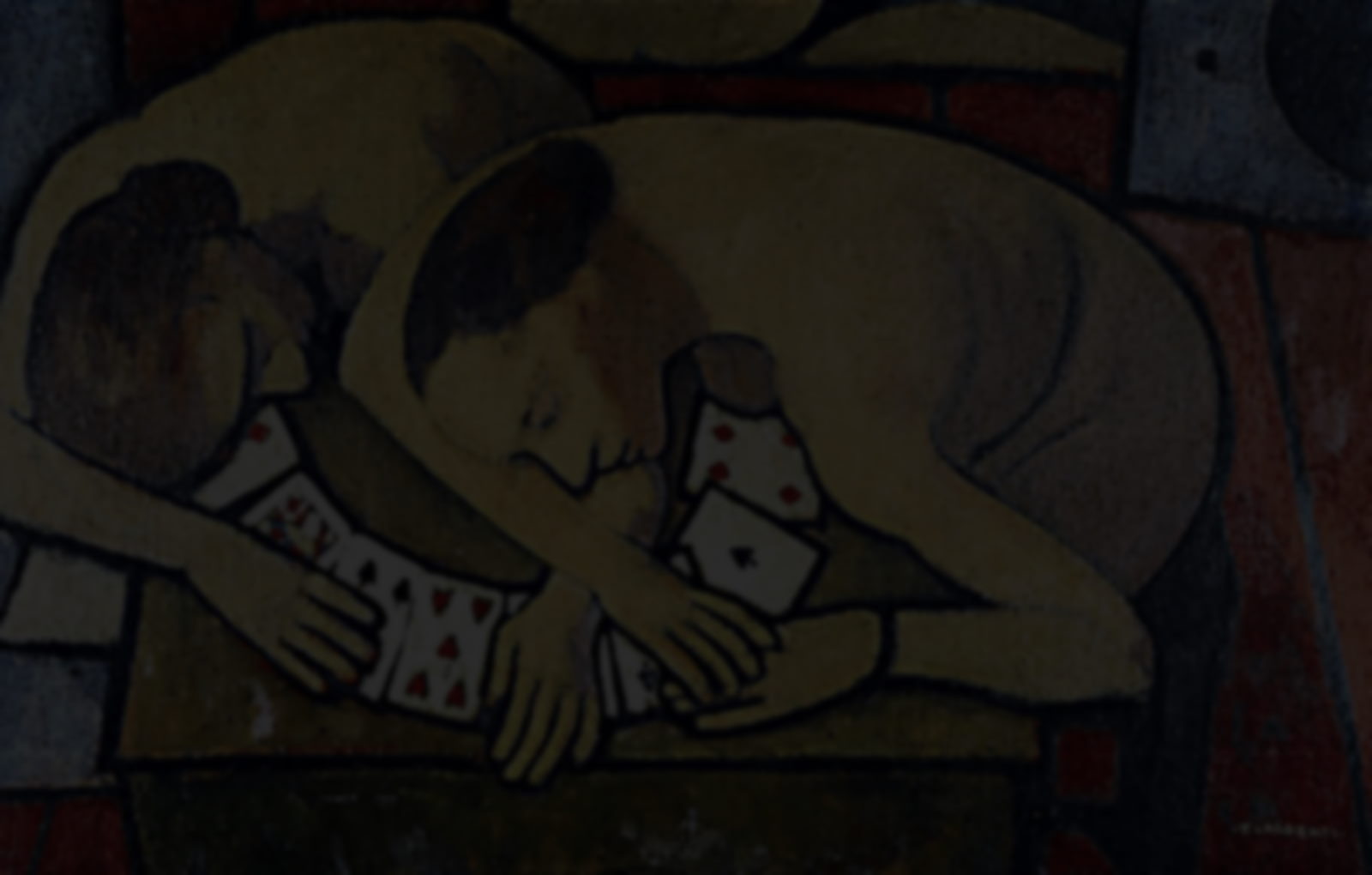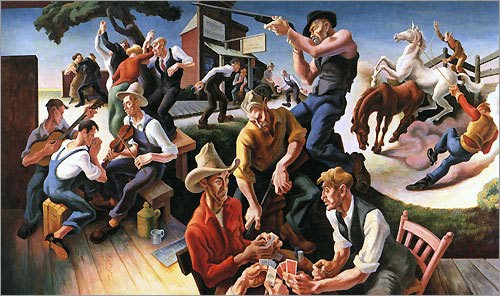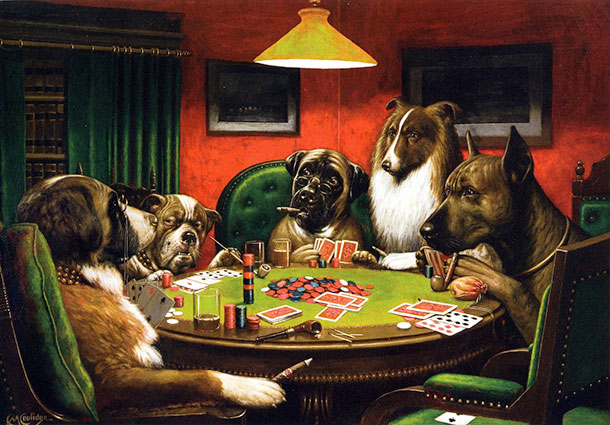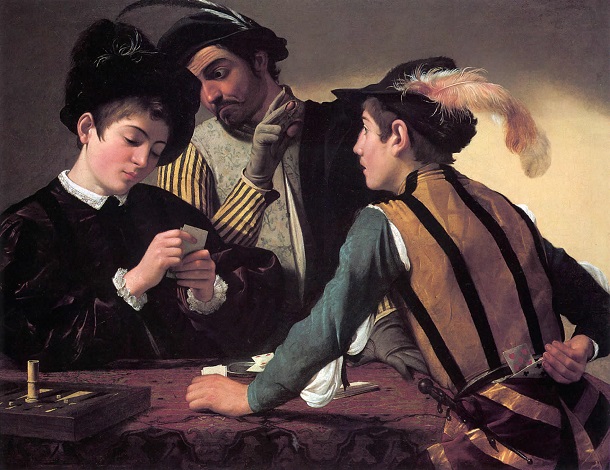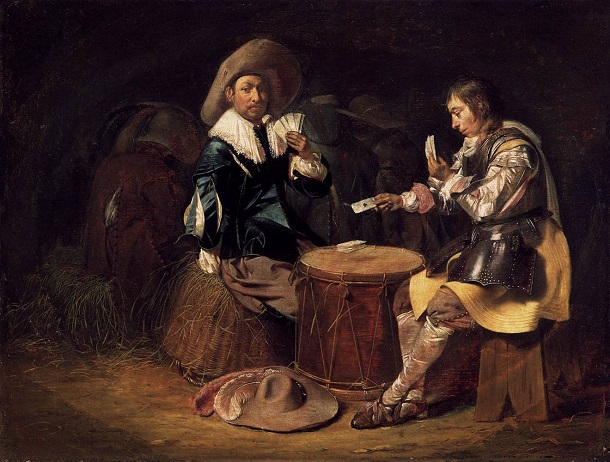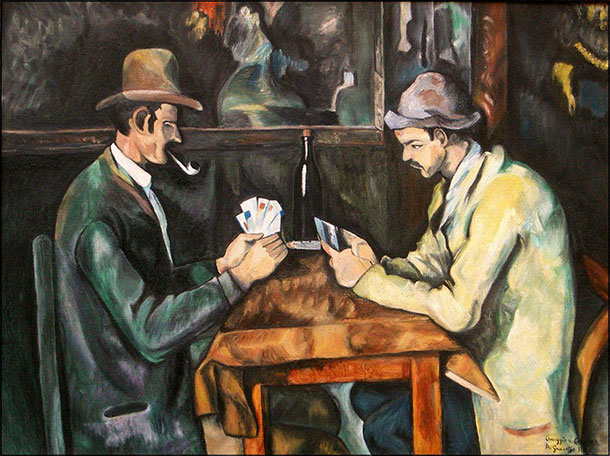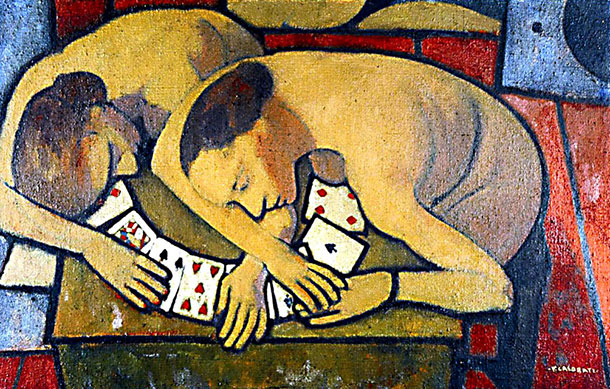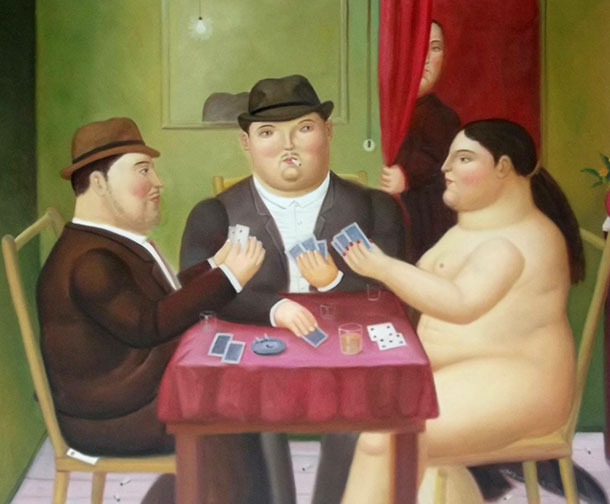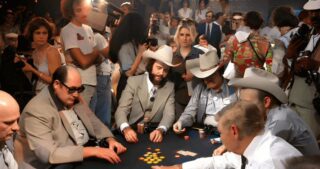Poker, or card games, as inspiration for some of the world's most legendary works of art? It's not as far-fetched as you might think. In fact dozens of the world's most famous painters - including Caravaggio, Cézanne and Picasso - found bottomless inspiration in the minutiae of cards, card games and its varied enthusiasts. PokerListings Italy's Francesco Esposito digs a little deeper.
Poker Night (from a streetcar named desire) (1948)
Everyone knows the movie (and some the play), but few know "A Streetcar Named Desire" is also a painting: "Poker Night (from a streetcar named desire)," produced by Thomas Hart Benton (1889-1975) in 1948.
The play was staged for the first time on Broadway in 1947 shortly after producer David O. Selznick commissioned the painting from Benton as a gift for his wife Irene. Like all of Benton’s paintings "Poker Night" stands out for its sinuous lines.
Author Tennessee Williams won one of his two Pulitzer Prizes for Theater with this play. The first theatrical release of A Streetcar Named Desire, directed by Elia Kazan, was released in 1951.
In the painting, exhibited at the Whitney Museum in New York, you can clearly recognize the actors including Marlon Brando and Jessica Tandy. Tandy has been quoted as saying she didn’t like the way Benton portrayed her with a thin dress that revealed a bit too much.
The revealing dress is one of a few details typical to the liberal interpretations of the Missouri artist. Photos taken during the play show Tandy appears in a more chaste dress with ruffles and fringes.
"No Women When Playing"
Back to the picture and the movie. Stanley (Marlon Brando) is playing poker at home in the company of three friends. His wife and sister-in-law have returned sooner than expected. He’s made even more nervous by the fact that he’s losing.
A short distance away behind a curtain in the bedroom the radio plays a waltz: Stanley is annoyed while Blanche (Tandy) dances to the music. In the film Stanley throws the radio out the window shortly after. The other players try to calm him down by putting him under a cold shower.
"Poker should not be played in a house in the presence of women," says Mitch, Blanche’s suitor.
Arts of the West (1932)
Another painting where Benton depicts poker players is "Arts of the West,” part of a series of large murals initially intended for the Whitney Museum.
As usual Benton shows more scenes of life in the same painting. In this case, the common denominator is the West.
The work of Benton is associated with the group of American Regionalists, who offered a figurative style in contrast to the European avant-garde.
Benton inspired many artists like the Mexican painter Diego Rivera, famous for his murals, and his pupil Jackson Pollock, the legend of Abstract Expressionism.
Dogs Playing Poker (1903)
The game of poker is not just the prerogative of the human species, as evidenced by the Dogs Playing Poker series of paintings by Cassius Marcellus Coolidge.
The nine paintings, cited in numerous TV shows, cartoons and even in song, were commissioned from the American painter by advertising firm Brown & Bigelow.
Caravaggio’s “The Cardsharps” (1594)
Going back about three centuries the famous painting “The Cardsharps” by Michelangelo Merisi, also known as Caravaggio (1571-1610), represents two young boys playing Zarro, a card game which was very popular in Italy during the time of the Renaissance.
The painting, done in 1594, is now exhibited at the Kimbell Art Museum in Fort Worth (Texas). The Cardinal Francesco Maria Del Monte commissioned it from Caravaggio. During his stay at Del Monte’s the artist’s popularity grew among the Roman nobility.
Zarro is considered by many to be an ancestor of poker as points were given to twins, both set and color. The set had 20 cards, five of which were available to each player. Considered “socially dangerous,” Zarro was prohibited by Milan by a 1531 edict from Francesco Sforza, which did not however stop the game from spreading.
"The Cardsharps” are the young boy depicted from the back and his older accomplice: this latter one peaks at the victim’s cards and shows a three with his hand, maybe indicating that he has a set.
The players are using a set of Italians cards which show a French influence. A four of diamonds is placed by one of the cardsharps on the table. The young dishonest boy holds a seven of hearts and a six of clubs behind his back: thanks to his accomplice’s signal, he can switch the six of clubs with one of his cards.
The Theater of Poker
Even in this work of art it’s as if Caravaggio put together a theatrical representation of poker. The theme and subjects - especially the man watching the game - are depicted in a way that resembles a ‘commedia dell’arte’ scene.
The torn gloves of the prompter, the most visible of which is the one on the right gesticulating hand, represent a comic element. The cheaters contrast the honest boy through their movements: the former two express tension and dynamism even through their glances while the “cheated” appears reflective and relaxed in his manner of sitting and looking at the cards.
It's probably the victim’s turn considering his level of concentration.
Tips for Getting Lucky
The theme of card playing in works of art has also been investigated by Joseph Leonard Goldstein, a biochemist and geneticist who was awarded the Nobel Prize in Medicine.
Goldstein explored the connection in an article published by the journal Nature Medicine entitled “The card players of Caravaggio, Cézanne and Mark Twain: Tips for getting lucky in high-stakes research.”
Apart from analyzing the analogies between poker and scientific research, Goldstein examines certain paintings including “The Cardsharps” by Caravaggio, “The cheat with the ace of diamonds,” by Georges de La Tour and “The card players,” by Cézanne.
In his article Goldstein notes that in the late 1300s, when card playing had become a popular method of entertainment in Italy and in France, tricks and cheats had overcome ability. This situation also emerges in Caravaggio’s painting.
The American Nobel prize winner explains how several distinguished painters are influenced by Caravaggio’s “Cardsharps,” over the following 300 years.
In 2006 96-year-old collector Denis Mahon bought a copy of “The Cardsharps” for 50,000 GBP at an auction by Sotheby’s in London. A year later it was discovered that the painting was an original by Caravaggio, finished before the painting exhibited in the American museum (although attribution, as well as the date of the painting, remain uncertain).
Soldiers Playing Cards
Caravaggio’s style influenced a lot of young European painters, like France’s Valentin de Boulogne.
de Boulogne represented card and dice games several times in his work, as in his “Soldiers playing cards” (in the image above).
The painting depicts the scene from a slightly different perspective and was later given a permanent spot in the Ashmolean Museum in Oxford.
The Cheat with the Ace of Diamonds
The same theme in Caravaggio’s painting was revisited in “The cheat with the ace of diamonds” by Georges de La Tour (1593-1652), finished in 1635, which represents the temptations offered by women, wine and play.
Even in this case the construction of glances is given a lot of importance: the oblique look given by the courtesan to the maid who is about to serve her wine; the one by the cheat with cards hidden behind his back; and the one of the young man on the right, probably unaware of what is going on.
It is not to be missed that the courtesan’s look is directed towards the cheat instead of the maid. In another version of the painting, de La Tour depicts an ace of clubs instead of an ace of diamonds.
The Card Players
In 2012 Vanity Fair magazine revealed that the famous “Card players” by Cézanne was acquired by the Qatar royal family for $250 million. One-upping the offers of art merchants Larry Gagosian and William Acquavella, the Arab royals acquired the most expensive painting in art history.
The previous record, for “Number 5” by Jackson Pollock, sold in 2006 for $140 million.
The painting by Cézanne forms part of a cycle of five works done between 1890 and 1895 in which different peasants were depicted playing cards.
The subjects were probably workers who served in the property of Cézanne’s family outside of Aix-en-Provence. The man on the left with the pipe is the Pere Alexandre, the farmer, while the other man is Paulin Paulet, the gardener.
As noted once again by Goldstein the players are so absorbed by the game that they prefer staring at the cards rather than looking at each other. Art critic Meyer Shapiro has defined the painting as “collective solitaire.”
The contrast between “The Cardsharps” by Caravaggio and “The card players” is impressive. Writes Goldstein:
“Unlike Caravaggio's masterpiece, Cézanne's seminal series depicts no cheating, no money on the table, no melodrama, no skullduggery, no extravagant clothes.
“Cézanne is telling us in no uncertain terms that card play is no laughing matter. The key to skillful play and winning is focus, focus, focus. Luck is not necessary when there are no distractions and no trickery of the Caravaggio type.
“As to which is more important, luck or skill, Caravaggio leans toward luck and Cézanne favors skill”.
Apart from the one in the hands of the Qatar royal family the other paintings that formed the series can be found in London (Courtauld Institute of Art), New York (Metropolitan Museum) and at the Musèe d’Orsay in Paris.
Before it was sold to the royal family “The card players” belonged to Greece’s George Embiricos, who had refused to separate himself from it but changed his mind shortly before dying.
The painting by Paul Cézanne (1839-1906) anticipates the cubism which followed with regards the representation of reality and the simplification of form. Cubism had Pablo Picasso amongst its major exponents.
"Card Players" (1913)
Picasso's “Card players” (1913), in particular, shows synthetic cubism and exhibits a personal representation of reality. Among the characteristic features we find some playing cards and abstract motifs that probably represent mouldings and decorations of a hypothetical pub.
The particular predilection by the synthetic cubists for letters and numbers, and so also for playing cards, is notable also in “Still life with playing cards” (1913) by Georges Braque, a friend and colleague of Picasso.
The painting “The card players” by Gino Severini (1924), on the other hand, falls under the movement defined as the “Return to order,” that proposed the return to figurative and more traditional art.
In this painting we find two characters of the Commedia dell’arte, which is a returning feature of this movement, being represented among the players.
"Women leaning on playing cards" (1954)
Echoes of Picasso’s painting can be found in “Women leaning on playing cards,” painted in 1954 by Felice Casorati.
"Card players"
There are several other well-known artists who have depicted games of cards in a number of paintings.
A Colombian sculptor and painter with an unmistakable figurative style, Fernando Botero Angulo depicted several scenes of card players in his works - frequently with a nude woman involved.
